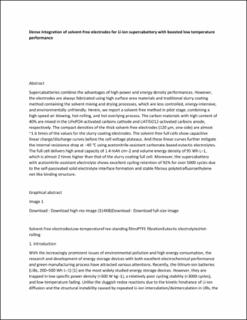| dc.contributor.author | Zhou, Haitao | |
| dc.contributor.author | Liu, Menghao | |
| dc.contributor.author | Gao, Hongquan | |
| dc.contributor.author | Hou, Dong | |
| dc.contributor.author | Yu, Chongchen | |
| dc.contributor.author | Liu, Chao | |
| dc.contributor.author | Zhang, Dong | |
| dc.contributor.author | Wu, Jian-Chun | |
| dc.contributor.author | Yang, Jianhong | |
| dc.contributor.author | Chen, De | |
| dc.date.accessioned | 2021-03-09T08:33:27Z | |
| dc.date.available | 2021-03-09T08:33:27Z | |
| dc.date.created | 2020-09-08T15:47:50Z | |
| dc.date.issued | 2020 | |
| dc.identifier.citation | Journal of Power Sources. 2020, 473:228553 1-9. | en_US |
| dc.identifier.issn | 0378-7753 | |
| dc.identifier.uri | https://hdl.handle.net/11250/2732279 | |
| dc.description.abstract | Supercabatteries combine the advantages of high power and energy density performances. However, the electrodes are always fabricated using high surface area materials and traditional slurry coating method containing the solvent mixing and drying processes, which are less controlled, energy-intensive, and environmentally unfriendly. Herein, we report a solvent-free method in pilot stage, combining a high-speed air blowing, hot-rolling, and hot overlying process. The carbon materials with high content of 40% are mixed in the LiFePO4-activated carbons cathode and Li4Ti5O12-activated carbons anode, respectively. The compact densities of the thick solvent-free electrodes (120 μm, one-side) are almost ~1.6 times of the values for the slurry coating electrodes. The solvent-free full cells show capacitive linear charge/discharge curves before the cell voltage plateaus. And these linear curves further mitigate the internal resistance drop at −40 °C using acetonitrile-assistant carbonate-based eutectic electrolytes. The full cell delivers high areal capacity of 1.4 mAh cm−2 and volume energy density of 95 Wh L−1, which is almost 2 times higher than that of the slurry coating full cell. Moreover, the supercabattery with acetonitrile-assistant electrolyte shows excellent cycling retention of 92% for over 5000 cycles due to the self-passivated solid electrolyte interface formation and stable fibrous polytetrafluoroethylene net-like binding structure. | en_US |
| dc.language.iso | eng | en_US |
| dc.publisher | Elsevier | en_US |
| dc.rights | Attribution-NonCommercial-NoDerivatives 4.0 Internasjonal | * |
| dc.rights.uri | http://creativecommons.org/licenses/by-nc-nd/4.0/deed.no | * |
| dc.title | Dense integration of solvent-free electrodes for Li-ion supercabattery with boosted low temperature performance | en_US |
| dc.type | Peer reviewed | en_US |
| dc.type | Journal article | en_US |
| dc.description.version | acceptedVersion | en_US |
| dc.source.pagenumber | 1-9 | en_US |
| dc.source.volume | 473:228553 | en_US |
| dc.source.journal | Journal of Power Sources | en_US |
| dc.identifier.doi | 10.1016/j.jpowsour.2020.228553 | |
| dc.identifier.cristin | 1828182 | |
| dc.relation.project | Norges forskningsråd: 262399 | en_US |
| dc.description.localcode | "© 2020. This is the authors’ accepted and refereed manuscript to the article. Locked until 22.7.2022 due to copyright restrictions. This manuscript version is made available under the CC-BY-NC-ND 4.0 license http://creativecommons.org/licenses/by-nc-nd/4.0/ " | en_US |
| cristin.ispublished | true | |
| cristin.fulltext | postprint | |
| cristin.qualitycode | 1 | |

